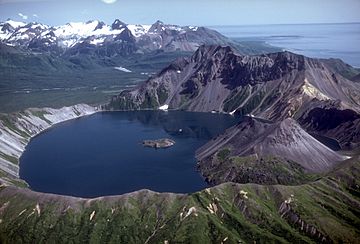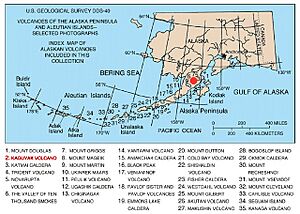Mount Kaguyak facts for kids
Quick facts for kids Mount Kaguyak |
|
|---|---|

Lake filled caldera of Kaguyak, August 1982.
|
|
| Highest point | |
| Elevation | 2,956 ft (901 m) |
| Listing | List of volcanoes in the United States |
| Geography | |
| Parent range | Aleutian Range |
| Geology | |
| Mountain type | Stratovolcano |
| Volcanic arc/belt | Aleutian Arc |
| Last eruption | 3850 BCE |
Mount Kaguyak is a cool type of volcano called a stratovolcano. It's found in a beautiful place called Katmai National Park and Preserve in Alaska, USA. Imagine a giant bowl at the top of the volcano – that's its caldera! This bowl is about 2.5 kilometers (1.5 miles) wide and is filled with a deep lake. This lake is more than 180 meters (590 feet) deep! The lake's surface is about 550 meters (1,800 feet) lower than the caldera's edge. In the middle of the lake, there's even a cool peninsula formed by old lava domes.
Mount Kaguyak stands about 901 meters (2,956 feet) tall. It looks very impressive because it rises up from flat, low areas near the sea, especially south of the Big River.
What is Mount Kaguyak?
Mount Kaguyak is a stratovolcano, which means it's a tall, cone-shaped volcano built up by many layers of hardened lava, ash, and rocks. These volcanoes often have explosive eruptions. Kaguyak is part of the Aleutian Range, a chain of mountains and volcanoes in Alaska.
The Caldera and Its Lake
One of the most interesting features of Mount Kaguyak is its large caldera. A caldera is like a huge crater that forms when a volcano erupts very powerfully and its top collapses inward. Kaguyak's caldera is quite wide, measuring about 2.5 kilometers (1.5 miles) across.
Inside this big bowl, there's a deep crater lake. This lake is more than 180 meters (590 feet) deep, which is like stacking over 30 school buses on top of each other! The water in the lake sits much lower than the rim of the caldera, about 550 meters (1,800 feet) below it. You can also see a unique peninsula sticking out into the middle of the lake. This peninsula was formed by lava domes that grew after the main caldera-forming eruption.
Mount Kaguyak's Big Eruption
The biggest event in Mount Kaguyak's history was a massive eruption that happened about 5,800 years ago. Scientists figured out this date using a method called radiocarbon dating. This is a way to tell how old something is by looking at a special type of carbon inside it.
During this huge eruption, the volcano exploded with incredible force. This is when the large caldera we see today was formed. The eruption also covered a massive area with volcanic material. About 120 square kilometers (46 square miles) of land were covered in a type of volcanic ash and rock called ignimbrite. This shows just how powerful the eruption was!



